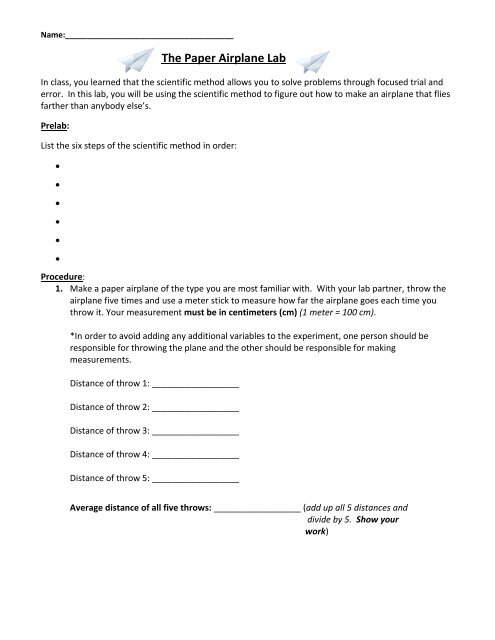The Paper Airplane Lab
The Paper Airplane Lab
The Paper Airplane Lab
Create successful ePaper yourself
Turn your PDF publications into a flip-book with our unique Google optimized e-Paper software.
Name:______________________________________<br />
<strong>The</strong> <strong>Paper</strong> <strong>Airplane</strong> <strong>Lab</strong><br />
In class, you learned that the scientific method allows you to solve problems through focused trial and<br />
error. In this lab, you will be using the scientific method to figure out how to make an airplane that flies<br />
farther than anybody else’s.<br />
Prelab:<br />
List the six steps of the scientific method in order:<br />
<br />
<br />
<br />
<br />
<br />
<br />
Procedure:<br />
1. Make a paper airplane of the type you are most familiar with. With your lab partner, throw the<br />
airplane five times and use a meter stick to measure how far the airplane goes each time you<br />
throw it. Your measurement must be in centimeters (cm) (1 meter = 100 cm).<br />
*In order to avoid adding any additional variables to the experiment, one person should be<br />
responsible for throwing the plane and the other should be responsible for making<br />
measurements.<br />
Distance of throw 1: __________________<br />
Distance of throw 2: __________________<br />
Distance of throw 3: __________________<br />
Distance of throw 4: __________________<br />
Distance of throw 5: __________________<br />
Average distance of all five throws: __________________ (add up all 5 distances and<br />
divide by 5. Show your<br />
work)
2. Now make a guess about what might make the paper airplane fly farther. This could include an<br />
alteration in the plane’s design, a different method of throwing it, or any other change you can<br />
think of. You may change whatever you like, but remember to only change one thing. In the<br />
spaces below, write down how you think that you can get a better flight distance using the<br />
scientific method.<br />
Purpose Statement (What is the goal of your experiment):<br />
Hypothesis (Write in an “if/then” format):<br />
Material (Include everything you used):<br />
Procedure for making your plane: Discuss the steps it took to fold your plane as well as the<br />
procedure for throwing your plane<br />
Results:<br />
Distance of throw 1: __________________<br />
Distance of throw 2: __________________<br />
Distance of throw 3: __________________<br />
Distance of throw 4: __________________<br />
Distance of throw 5: __________________<br />
Average distance of all five throws: ______________ (Show your work below)
Analysis/Conclusion: How did the changes you made affect your results Make sure to reference specific<br />
data from your trials. This section should include specific details from your experiment and be at least<br />
three sentences in length. Make sure to include at least two potential errors in your experiment.<br />
Analysis Questions: You must answer all of the following questions using complete sentences<br />
1. Was your hypothesis disproved or confirmed Explain using the data you obtained in your<br />
experiment.<br />
2. Explain why it was important that you change only one variable between your initial experiment<br />
and your later experiment.<br />
3. If you were to perform this experiment again, what changes would you make This can include<br />
changes in your procedure, the design of your plane, or anything else you wish to discuss.<br />
4. When working in the lab, scientists do not necessarily follow the steps of the scientific method in<br />
a certain order. What changes would you make to the scientific method if you were a scientist<br />
working in a lab


